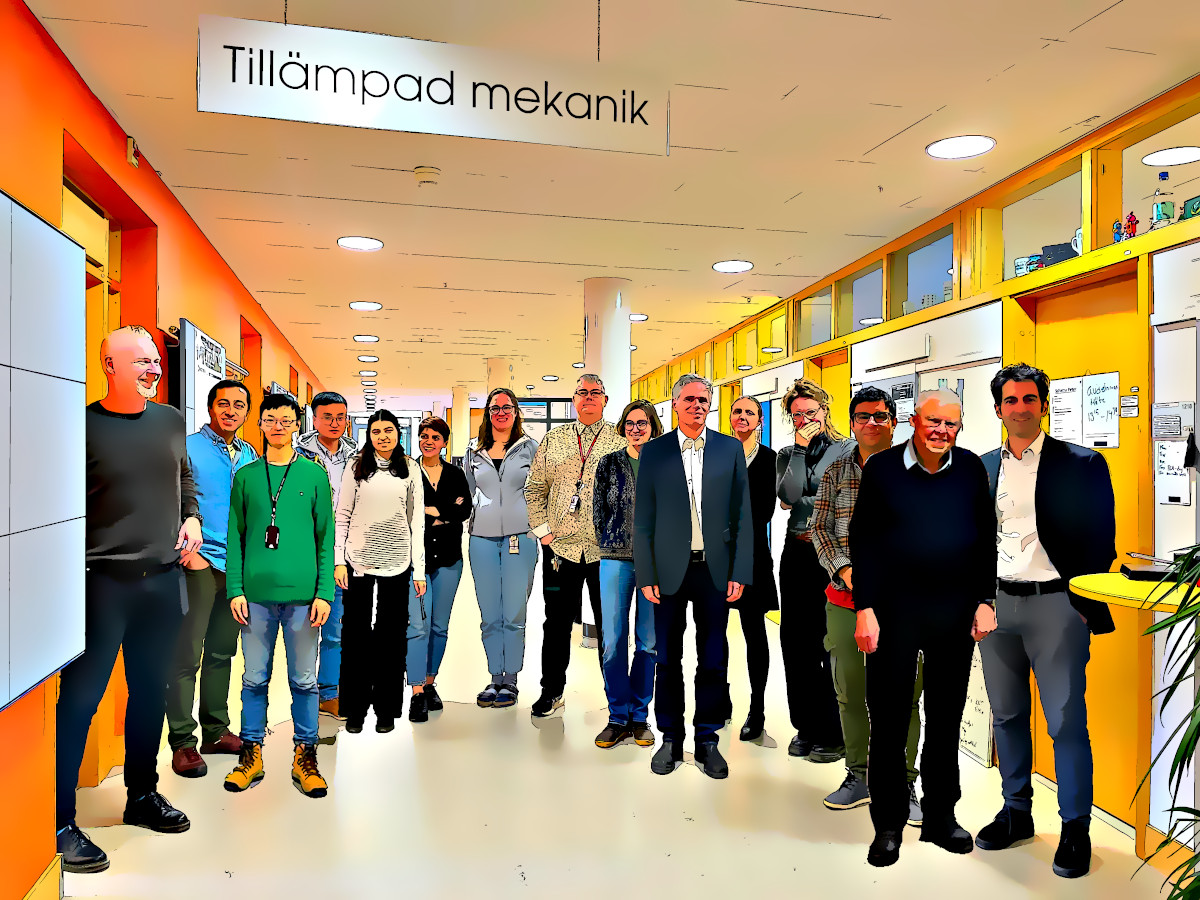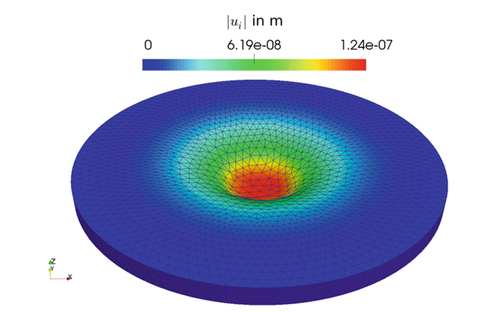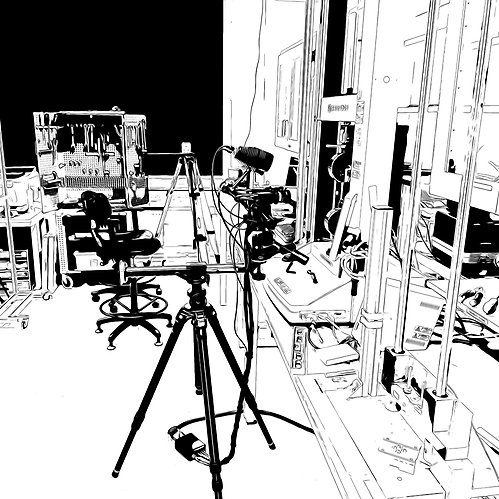Applied Mechanics

The Division of Applied Mechanics is part of the Department of Materials Science and Engineering
Applied mechanics is a broad field involving structures, solids and fluids. Our work mainly focuses on material and structural mechanics.
Welcome to Applied Mechanics
Seeing is believing, but measuring and computing are far more convincing! Modern experimental techniques, in combination with image analyses and high-precision computational methods, are our powerful tools for understanding the fundamental mechanical behavior of complex structures and materials over length and time scales.
Our research is multidisciplinary and spans from applied projects in close cooperation with industry to fundamental academic research. We develop computational models and use high-precision clusters for multiscale and multiphysics simulations. We develop experimental devices and capture three-dimensional deformation fields even at submicron scale. We fabricate and recycle composite materials with highest design freedom by additive manufacturing.
Want to know more?
Education
We teach in the Bachelor of Engineering programmes in civil engineering and mechanical engineering, as well as in mechanics courses in the Master of Engineering programmes.
We regularly give PhD courses in e.g. continuum mechanics and finite element modelling.
Information about programmes at the department can be found in the student entrance.
Post graduate
Research Methodology, FTN0412
Multiphysics Modeling and Computation of Coupled and Nonlinear Problems
Advanced Continuum Mechanics
Doctoral studies
We regularly give doctoral courses in e.g. continuum mechanics and finite element modelling. If you want to become a doctoral student at the division, apply for an advertised doctoral position. We regularly give doctoral courses in e.g. continuum mechanics and finite element modelling.
More information about doctoral education at the department
Get to know our former PhD students
For more information about the specialisation, please contact Professor Kristofer Gamstedt.
Welcome to contact us
You are welcome to visit us at Ångströmlaboratoriet Lägerhyddsvägen 1, Uppsala.
Head of Division: Professor Kristofer Gamstedt, phone 070-425 03 82
Publications
Nonlinear wave propagation in graphene incorporating second strain gradient theory
Part of Thin-walled structures, 2024
- DOI for Nonlinear wave propagation in graphene incorporating second strain gradient theory
- Download full text (pdf) of Nonlinear wave propagation in graphene incorporating second strain gradient theory
Part of Computers & structures, 2024
- DOI for Computational simulation and acoustic analysis of two-dimensional nano-waveguides considering second strain gradient effects
- Download full text (pdf) of Computational simulation and acoustic analysis of two-dimensional nano-waveguides considering second strain gradient effects
Experimental and numerical study on hydrogen-induced failure of X65 pipeline steel
Part of Materials Science & Engineering, 2024
- DOI for Experimental and numerical study on hydrogen-induced failure of X65 pipeline steel
- Download full text (pdf) of Experimental and numerical study on hydrogen-induced failure of X65 pipeline steel
Part of Holzforschung, p. 98-108, 2024
Part of Wood Material Science & Engineering, p. 2140-2149, 2023
- DOI for Moisture gradients in sawn timber during aggressive kiln drying investigated with X-ray computed tomography
- Download full text (pdf) of Moisture gradients in sawn timber during aggressive kiln drying investigated with X-ray computed tomography
Part of Holzforschung, p. 793-815, 2023
- DOI for An overview of lab-based micro computed tomography aided finite element modelling of wood and its current bottlenecks
- Download full text (pdf) of An overview of lab-based micro computed tomography aided finite element modelling of wood and its current bottlenecks
Energy based methods applied in mechanics by using the extended Noether's formalism
Part of Zeitschrift für angewandte Mathematik und Mechanik, 2023
- DOI for Energy based methods applied in mechanics by using the extended Noether's formalism
- Download full text (pdf) of Energy based methods applied in mechanics by using the extended Noether's formalism
Magnetron sputtered high entropy alloy/amorphous carbon nanocomposite coatings
Part of Materials Today Communications, 2023
- DOI for Magnetron sputtered high entropy alloy/amorphous carbon nanocomposite coatings
- Download full text (pdf) of Magnetron sputtered high entropy alloy/amorphous carbon nanocomposite coatings
Part of Journal of Materials Science & Technology, p. 225-236, 2024
- DOI for Hydrogen trapping and diffusion in polycrystalline nickel: The spectrum of grain boundary segregation
- Download full text (pdf) of Hydrogen trapping and diffusion in polycrystalline nickel: The spectrum of grain boundary segregation
An improved trabecular bone model based on Voronoi tessellation
Part of Journal of The Mechanical Behavior of Biomedical Materials, 2023
- DOI for An improved trabecular bone model based on Voronoi tessellation
- Download full text (pdf) of An improved trabecular bone model based on Voronoi tessellation
Part of Mechanics of time-dependant materials, 2023
Creep aspects of softwood from the cell-wall level to structures
2023
Feasiblity of wooden towers for offshore wind turbines: Creep and fatigue predictions
A micro-CT investigation of densification in pressboard due to compression
Part of Strain, 2023
- DOI for A micro-CT investigation of densification in pressboard due to compression
- Download full text (pdf) of A micro-CT investigation of densification in pressboard due to compression
Part of International Journal of Impact Engineering, 2023
- DOI for Realization of shorter substitutes for a percussive rock drill hammer by periodic redistribution of its mass and compliance
- Download full text (pdf) of Realization of shorter substitutes for a percussive rock drill hammer by periodic redistribution of its mass and compliance
Part of Holzforschung, 2023
- DOI for Microscopic computed tomography aided finiteelement modelling as a methodology to estimatehygroexpansion coefficients of wood: a case studyon opposite and compression wood in softwoodbranches
- Download full text (pdf) of Microscopic computed tomography aided finiteelement modelling as a methodology to estimatehygroexpansion coefficients of wood: a case studyon opposite and compression wood in softwoodbranches
Part of Bioengineering, 2023
- DOI for Analytical Study of Stress Distributions around Screws in Flat Mandibular Bone under In-Plane Loading
- Download full text (pdf) of Analytical Study of Stress Distributions around Screws in Flat Mandibular Bone under In-Plane Loading
An Introduction to Piezoelectric and Thermoelectric Materials
Part of Handbook of Energy Materials, p. 1-18, Springer, 2022
Part of Sixty Shades of Generalized Continua, p. 631-644, Springer, 2023
Dissipative Mechano-Electro-Magnetism Simulations in Electronic Components
Part of Sixty Shades of Generalized Continua, p. 463-478, Springer, 2023
Effects of 3-D Printing Infill Density Parameter on the Mechanical Properties of PLA Polymer
Part of Sixty Shades of Generalized Continua, p. 1-12, Springer, 2023
Part of Applied Composite Materials, p. 987-1001, 2023
- DOI for Nonlinear Material Modeling for Mechanical Characterization of 3-D Printed PLA Polymer With Different Infill Densities
- Download full text (pdf) of Nonlinear Material Modeling for Mechanical Characterization of 3-D Printed PLA Polymer With Different Infill Densities
Part of Zeitschrift für angewandte Mathematik und Mechanik, 2023
Linear and Nonlinear Mechanics of Lattice Materials: Computational Modelling and Experiments
2023
Part of Continuum Mechanics and Thermodynamics, 2023
- DOI for Second-order homogenization of 3-D lattice materials towards strain gradient media: numerical modelling and experimental verification
- Download full text (pdf) of Second-order homogenization of 3-D lattice materials towards strain gradient media: numerical modelling and experimental verification
Part of Materials & design, 2023
- DOI for Mechanical coupling and tuned anisotropic elasticity: Numerical and experimental material design for shear-normal and shear-shear interactions
- Download full text (pdf) of Mechanical coupling and tuned anisotropic elasticity: Numerical and experimental material design for shear-normal and shear-shear interactions
Viscoelastic behavior of softwood based on a multiscale computational homogenization
Part of Mechanics of materials, 2023
- DOI for Viscoelastic behavior of softwood based on a multiscale computational homogenization
- Download full text (pdf) of Viscoelastic behavior of softwood based on a multiscale computational homogenization
Towards Self-Reinforced PLA Composites for Fused Filament Fabrication
Part of Applied Sciences, 2023
- DOI for Towards Self-Reinforced PLA Composites for Fused Filament Fabrication
- Download full text (pdf) of Towards Self-Reinforced PLA Composites for Fused Filament Fabrication
An applicable orthotropic creep model for wood materials and composites
Part of Wood Science and Technology, p. 1585-1604, 2022
- DOI for An applicable orthotropic creep model for wood materials and composites
- Download full text (pdf) of An applicable orthotropic creep model for wood materials and composites
The dual role of hydrogen in grain boundary mobility
Part of Journal of Applied Physics, 2023
Part of International Journal of Solids and Structures, 2023
- DOI for An extended hydrostatic-deviatoric strain energy density decomposition for phase-field fracture theories
- Download full text (pdf) of An extended hydrostatic-deviatoric strain energy density decomposition for phase-field fracture theories
Fracture in porous bone analysed with a numerical phase-field dynamical model
Part of Journal of The Mechanical Behavior of Biomedical Materials, 2023
- DOI for Fracture in porous bone analysed with a numerical phase-field dynamical model
- Download full text (pdf) of Fracture in porous bone analysed with a numerical phase-field dynamical model
Plate capacitor problem as a benchmark case for verifying the finite element implementation
Part of Continuum Mechanics and Thermodynamics, p. 245-265, 2023
- DOI for Plate capacitor problem as a benchmark case for verifying the finite element implementation
- Download full text (pdf) of Plate capacitor problem as a benchmark case for verifying the finite element implementation
Part of Computer Methods in Applied Mechanics and Engineering, 2023
- DOI for The study of diffuse interface propagation of dynamic failure in advanced ceramics using the phase-field approach
- Download full text (pdf) of The study of diffuse interface propagation of dynamic failure in advanced ceramics using the phase-field approach
An ex-vivo model for the biomechanical assessment of cement discoplasty
Part of Frontiers in Bioengineering and Biotechnology, 2022
- DOI for An ex-vivo model for the biomechanical assessment of cement discoplasty
- Download full text (pdf) of An ex-vivo model for the biomechanical assessment of cement discoplasty
Part of Mathematics and mechanics of solids, p. 2218-2238, 2022
- DOI for A benchmark strain gradient elasticity solution in two-dimensions for verifying computational approaches by means of the finite element method
- Download full text (pdf) of A benchmark strain gradient elasticity solution in two-dimensions for verifying computational approaches by means of the finite element method
Part of Mechanics research communications, 2022
- DOI for Experimental analysis on metamaterials boundary layers by means of a pantographic structure under large deformations
- Download full text (pdf) of Experimental analysis on metamaterials boundary layers by means of a pantographic structure under large deformations
Part of Continuum Mechanics and Thermodynamics, p. 159-181, 2023
- DOI for Generalized thermo-mechanical framework for heterogeneous materials through asymptotic homogenization
- Download full text (pdf) of Generalized thermo-mechanical framework for heterogeneous materials through asymptotic homogenization
Part of Mathematics and mechanics of solids, p. 2002-2016, 2022
- DOI for Investigating infill density and pattern effects in additive manufacturing by characterizing metamaterials along the strain-gradient theory
- Download full text (pdf) of Investigating infill density and pattern effects in additive manufacturing by characterizing metamaterials along the strain-gradient theory
Mortar cure-dependent effects on adhesive anchor systems loaded in tension
Part of Construction and Building Materials, 2023
- DOI for Mortar cure-dependent effects on adhesive anchor systems loaded in tension
- Download full text (pdf) of Mortar cure-dependent effects on adhesive anchor systems loaded in tension
Multiphysics Computation of Thermomechanical Fatigue in Electronics Under Electrical Loading
Part of Current Trends and Open Problems in Computational Mechanics, p. 1-14, Springer Nature, 2022
Phase-field approach to evolution and interaction of twins in single crystal magnesium
Part of Computational Mechanics, p. 803-818, 2022
- DOI for Phase-field approach to evolution and interaction of twins in single crystal magnesium
- Download full text (pdf) of Phase-field approach to evolution and interaction of twins in single crystal magnesium
Part of Theoretical Analyses, Computations, and Experiments of Multiscale Materials, p. 343-357, Springer Nature, 2022
Part of International Journal of Solids and Structures, 2022
- DOI for Thermodynamically-consistent derivation and computation of twinning and fracture in brittle materials by means of phase-field approaches in the finite element method
- Download full text (pdf) of Thermodynamically-consistent derivation and computation of twinning and fracture in brittle materials by means of phase-field approaches in the finite element method
Part of Journal of The Mechanical Behavior of Biomedical Materials, 2022
Numerical analysis of crack path stability in brittle porous materials
Part of Engineering Fracture Mechanics, 2022
- DOI for Numerical analysis of crack path stability in brittle porous materials
- Download full text (pdf) of Numerical analysis of crack path stability in brittle porous materials
Hydrogen embrittlement in micro-architectured materials
Part of Engineering Fracture Mechanics, 2022
- DOI for Hydrogen embrittlement in micro-architectured materials
- Download full text (pdf) of Hydrogen embrittlement in micro-architectured materials



